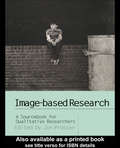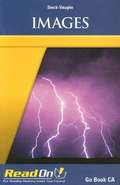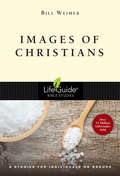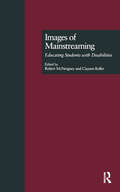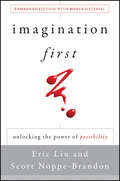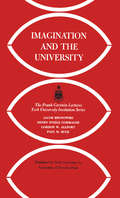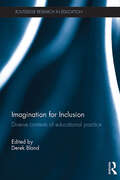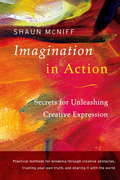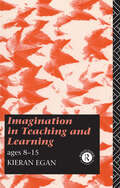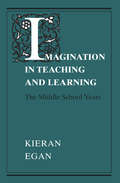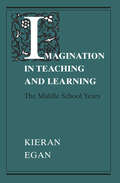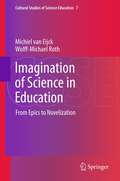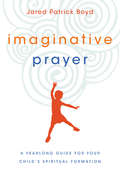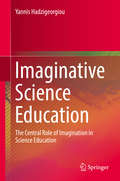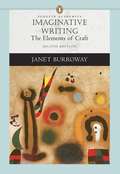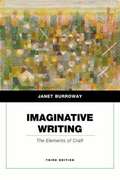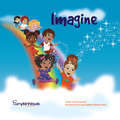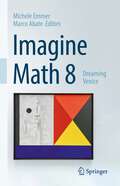- Table View
- List View
Image-based Research: A Sourcebook for Qualitative Researchers
by Jon ProsserJust what is a picture worth? Qualitative research is dominated by language. However, researchers have recently shown a growing interest in adopting an image-based approach. This is the first volume dedicated to exploring this approach and will prove an invaluable sourcebook for researchers in the field. The book covers a broad scope, including theory and the research process; and provides practical examples of how image-based research is applied in the field. It discusses use of images in child abuse investigation; exploring children's drawings in health education; cartoons; the media and teachers.
Imagery and Text: A Dual Coding Theory of Reading and Writing
by Allan Paivio Mark SadoskiImagery and Text, Second Edition extends the first edition’s unified theory of cognition in literacy from the perspective of Dual Coding Theory (DCT), one of the most influential and empirically sound theories of cognition ever developed. This theory provides a comprehensive, systematic account of all major aspects of literacy including decoding, comprehension, and response in reading and composing in writing. The Second Edition updates DCT as a scientific theory, a cognitive theory, an embodied theory, and a constructivist theory of literacy. New content includes a detailed account of the decoding process and its integral connection to comprehension, a new program of research on DCT in composing text, a review of neuroscientific support, and increased attention to multimedia literacy, socio-cultural influences, and recent educational applications. More than any other theory, DCT explains how both verbal and nonverbal cognition are woven together through all aspects of literacy. Written in concise chapters with illustrative examples, Imagery and Text is approachable for both students and advanced scholars in the field of literacy.
Images (Read On! Go Book CA)
by Harcourt Achieve30 short stories designed to increase reading comprehension.
Images of Christians: 8 Studies for Individuals or Groups (LifeGuide Bible Studies)
by Bill WeimerScripture offers various metaphors and motifs for God's people: sheep, salt and light, branches, clay jars, friends, disciples, and more.®
Images of Mainstreaming: Educating Students with Disabilities (Source Books on Education #53)
by Clayton Keller Robert McnergneyFirst Published in 1999. Routledge is an imprint of Taylor & Francis, an informa company.
Images of Schoolteachers in America
by Gail E. Burnaford Pamela Bolotin JosephThis book explores images of schoolteachers in America from the beginning of the 20th century to the present, using a wide range of approaches to scholarship and writing. It is intended for both experienced and aspiring teachers to use as a springboard for discussion and reflection about the teaching profession and for contemplating these questions: What does it mean to be a teacher? What has influenced and sustained our beliefs about teachers? New in the second edition * The focus is shifted to the teaching profession as the 21st century unfolds. * The volume continues to explore teacher images through various genres--oral history, narrative, literature, and popular culture. In the second edition, the authors place more emphasis on the social-political context that has shaped teachers' daily experiences and the teaching profession itself. In the study of teacher images and schooling, the essays draw from feminist research methods and the critical tradition in educational inquiry to probe issues of power and authority, race, social class, and gender. * The emphasis is on the multidimensionality of teacher images rather than normative characterizations. * Six totally new chapters have been written for this new edition: an "invented interview" spanning 100 years of school teaching; portraits of progressive activist teachers; an exploration of teachers in fiction for young adults; a retrospective of the satirical cartoon show, The Simpsons; a study of crusading and caring teachers in films; and an overview of progressive classroom practices in "the new millennium." Seven chapters have been thoroughly revised to reflect current scholarship and the authors' evolving knowledge and interests.
Images of the Spirit (LifeGuide Bible Studies)
by Sandy Larsen Dale LarsenHow do you picture the Holy Spirit? Our imagination is likely to run to something like a vague fuzzy cloud. Or perhaps we think of an invisible, impersonal force. No wonder the Holy Spirit is often called "it." While Christians affirm that the Spirit is the third person of the Trinity, we struggle to think of him as a person at all. The Bible is clear that the Holy Spirit is a person. But how can human beings understand who he is? Scripture helps us by giving us strong word pictures of the Spirit as wind, fire, a counselor, anointing oil and more. As you go through these eight-session LifeGuide Bible Study by Dale and Sandy Larsen, you will find that your mental picture of the Spirit comes into focus. And even better, you will find that you can have a real relationship with the third person of the Trinity as you experience the power, comfort and gifts that flow out from the Spirit. For over three decades LifeGuide Bible Studies have provided solid biblical content and raised thought-provoking questions—making for a one-of-a-kind Bible study experience for individuals and groups. This series has more than 130 titles on Old and New Testament books, character studies, and topical studies. PDF download with a single-user license; available from InterVarsity Press and other resellers.
Imagina
by José A. Blanco C. Cecilia Tocaimaza-HatchImagina, 4th Edition, Looseleaf Student Edition
Imagination According to Humphrey (According to Humphrey #11)
by Betty G. BirneyHumphrey's eleventh adventure celebrates stories, writing, and the power of the imagination! <P><P> Imaginations are running wild in Mrs. Brisbane's class, but Humphrey is stumped. <P>His friends are writing about where they would go if they could fly, but Humphrey is HAPPY-HAPPY-HAPPY right where he is in Room 26. <P><P>It's pawsitively easy for Humphrey to picture exciting adventures with dragons and knights in the story Mrs. Brisbane is reading aloud. <P>He has no trouble coming up with Plans to help his friends and tricks to entertain them. <P>His imagination even goes a little too far when he wonders if Carlos's imaginary friend might be a ghost. <P>If only his imagination wouldn't disappear when he tries to write. Luckily, Humphrey likes a challenge, and Mrs. Brisbane has lots of writing tips that do the trick.
Imagination First
by Eric Liu Scott Noppe-Brandon Lincoln Center InstituteWhen imagination becomes habit, it can transform your work and your lifeThe best corporations know that innovative thinking is the only competitive advantage that cannot be outsourced. The best schools are those that create cultures of imagination. Now in paperback, Imagination First introduces a wide-variety of individuals who make a habit of imaginative thinking and creative action, offering a set of universal practices that anyone can use to transform their life at work, home, and play. These 28.5 practices will enable anyone to become more imaginative and to teach others to do so as well?from corporate executive to educator to platoon sergeant. Bonus content includesWinning "practices" submitted by the publicGuidelines for educators who want to cultivate creativity in their classroomsExpanded resource sectionThe book is filled with illustrative stories of creative leaders, teachers, artists, and scientists that clearly illustrate the original practices and new material that shows how to bring imagination to life.
Imagination and the University
by Henry Steele Commager Gordon W. Allport Jacob Bronowski Paul H. BuckThis volume, the Frank Gerstein Lectures for 1963, is the second series of Invitation Lectures to be delivered at York University. The theme "Imagination and the University" was appropriate for, as President Murray Ross states in this Foreword, it is in its early years that a university is sufficiently flexible to utilize imagination in its structure and in its curriculum. York University was in its third year when the Lectures were given.Four distinguished scholars present their views on the importance of an imaginative approach to the different academic disciplines, and to the conduct of life in contemporary society as a whole.Jacob Bronowski, speaking on Imagination in Art and Science, draws a clear and striking analogy between the role of imagination in mathematics and in poetry, drawing on his own experiences and contributions in both areas. He stresses that all creative works in art or science, must conform to the universal experience of mankind and to the private experiences of each man: the work of science, as of art, moves us profoundly, in mind and in emotion, when it matches our experience and at the same time points beyond it.Henry Steele Commager shows how important is the contribution to be made by an imaginative approach to politics, where, as in other fields of human experience, it must not be separated from reality, if it is to find expression in something more than words. He points to examples from the past and the present and asks for more imagination in public thinking, it fit our actions to the reality of change, citing the urgency of such twentieth-century phenomena as the status of Communist China, the predicted population explosion, and the threat of nuclear war. Professor Commager believes that the universities provide the key to this kind of approach, being a supreme example of the creative capacity of mankind, whose function it is to serve the commonwealth of learning.A different kind of insight is offered by Gordon W. Allport, whose subject is Imagination in Psychology. He believes that the present "impertinence" of psychology can best be cured by endowing it with more imagination. He demands a pluralistic approach to psychological investigation, which would not deny the insights yielded by traditional methods, with their characteristic minute analyses, but whose goal would be to fashion a conception of the human person that would exclude nothing that is valid, and at the same time preserve an ideal of rational consistency. This could lead, in turn, to a clear definition of the root motives of mankind, even to discovering new formulas for international peace by offsetting particularistic political demands. Finally, Paul H. Buck describes the Harvard House Plan as an example of Imagination and the Curriculum. This plan, modelled on the Oxford-Cambridge College system which is also followed in some Canadian universities, is an attempt to make all aspects of undergraduate life a process of education. And a truly liberal education for today and tomorrow, Professor Buck is confident, will combine a programme of general education, a programme of specialism, and a collegiate way of living.
Imagination for Inclusion: Diverse contexts of educational practice (Routledge Research in Education)
by Derek BlandImagination for Inclusion offers a reconsideration of the ways in which imagination engages and empowers learners across the education spectrum, from primary to adult levels and in all subject areas. Imagination as a natural, expedient, and exciting learning tool should be central to any approach to developing and implementing curriculum, but is increasingly undervalued as learners progress through the education system; this disregards not only imagination’s potential, but its paramount place in informing truly inclusive approaches to teaching and learning. This book presents a new theory of imagination and includes discussion about its application to teaching and learning to increase the engagement of disaffected students and reinvigorate their relationships with curriculum content. Chapters include key ideas and discussion surrounding the benefits of introducing imaginative practices into the classroom for learners from a range of marginalised backgrounds, such as young people with disabilities and adult learners from socio-economically disadvantaged environments. In exploring imagination in the practice of inclusive education, the book includes chapters from researchers and practitioners in education who have fresh ideas about how learners and teachers have benefited from introducing imaginative pedagogies. The diverse collection, featuring writers with backgrounds from early childhood to adult education, will be essential reading for academics and researchers in the fields of education, inclusive education, social policy, professional development, teacher education and creativity. It will be of particular interest to current and pre-service teachers who want to develop inclusive practice and increase the engagement of all students with formal education.
Imagination in Action: Secrets for Unleashing Creative Expression
by Shaun McniffHe's spent a career helping people access their creative potential, and now Shaun McNiff is sharing the secrets he's learned from observing his own creative process as well as that of others--both those who identify as artists and those who don't. The result is nothing less than a master class in creativity by one of the great creative theorists--and practitioners--of our time. "This is intended as a practical text," Shaun says, "a creativity primer, striving to capture the essential things that have been of use to me and others." The wealth of instruction he provides here in these essential things will be indispensable to artists of all stripes, as well as to all who strive to express themselves with honesty and authenticity using any of the media life makes available.
Imagination in Teaching and Learning: Ages 8 to 15
by Kieran EganYoung people learn most readily when their imaginations are engaged and teachers teach most successfully when they are able to see their subject matter from their pupils' point of view. It is, however, difficult to define imagination in practice and even more difficult to make full use of its potential. In this original and stimulating book, Kieran Egan, winner of the prestigous Grawemeyer award for education in 1991, discusses what imagination really means for children and young people in the middle years and what its place should be in the midst of the normal demands of classroom teaching and learning. Egan uses a bright and witty style to move from a brief history of the ways in which imagination has been regarded over the years, through a general discussion of the links between learning and imagination. A selection of sample lesson plans show teachers how they can encourage effective learning through stimulating pupils' imaginations in a variety of curriculum areas, including maths, science, social studies and language work.
Imagination in Teaching and Learning: The Middle School Years
by Kieran EganIt is widely believed that a child's imagination ought to be stimulated and developed in education. Yet, few teachers understand what imagination is or how it lends itself to practical methods and techniques that can be used easily in classroom instruction. In this book, Kieran Egan—winner of the prestigious Grawemeyer Award for his work on imagination—takes up where his Teaching as Story Telling left off, offering practical help for teachers who want to engage, stimulate, and develop the imaginative and learning processes of children between the ages of eight to fifteen. This book is not about unusually imaginative students and teachers. Rather, it is about the typical student's imaginative life and how it can be stimulated in learning, how the average teacher can plan to achieve this aim, and how the curriculum can be structured to help achieve this aim. Slim and determinedly practical, this book contains a wealth of concrete examples of curriculum design and teaching techniques structured to appeal specifically to children in their middle school years.
Imagination in Teaching and Learning: The Middle School Years
by Kieran EganIt is widely believed that a child's imagination ought to be stimulated and developed in education. Yet, few teachers understand what imagination is or how it lends itself to practical methods and techniques that can be used easily in classroom instruction. In this book, Kieran Egan—winner of the prestigious Grawemeyer Award for his work on imagination—takes up where his Teaching as Story Telling left off, offering practical help for teachers who want to engage, stimulate, and develop the imaginative and learning processes of children between the ages of eight to fifteen. This book is not about unusually imaginative students and teachers. Rather, it is about the typical student's imaginative life and how it can be stimulated in learning, how the average teacher can plan to achieve this aim, and how the curriculum can be structured to help achieve this aim. Slim and determinedly practical, this book contains a wealth of concrete examples of curriculum design and teaching techniques structured to appeal specifically to children in their middle school years.
Imagination of Science in Education
by Wolff-Michael Roth Michiel Van EijckResearchers agree that schools construct a particular image of science, in which some characteristics are featured while others end up in oblivion. The result is that although most children are likely to be familiar with images of heroic scientists such as Einstein and Darwin, they rarely learn about the messy, day-to-day practice of science in which scientists are ordinary humans. Surprisingly, the process by which this imagination of science in education occurs has rarely been theorized. This is all the more remarkable since great thinkers tend to agree that the formation of images -- imagination -- is at the root of how human beings modify their material world. Hence this process in school science is fundamental to the way in which scientists, being the successful agents in/of science education, actually create their own scientific enterprise once they take up their professional life. One of the first to examine the topic, this book takes a theoretical approach to understanding the process of imagining science in education. The authors utilize a number of interpretive studies in both science and science education to describe and contrast two opposing forces in the imagination of science in education: epicization and novelization. Currently, they argue, the imagination of science in education is dominated by epicization, which provides an absolute past of scientific heroes and peak discoveries. This opens a distance between students and today's scientific enterprises, and contrasts sharply with the wider aim of science education to bring the actual world of science closer to students. To better understand how to reach this aim, the authors offer a detailed look at novelization, which is a continuous renewal of narratives that derives from dialogical interaction. The book brings together two hitherto separate fields of research in science education: psychologically informed research on students' images of science and semiotically informed research on images of science in textbooks. Drawing on a series of studies in which children participate in the imagination of science in and out of the classroom, the authors show how the process of novelization actually occurs in the practice of education and outline the various images of science this process ultimately yields.
Imaginative Prayer: A Yearlong Guide for Your Child's Spiritual Formation
by Jared Patrick BoydHow do we help our kids connect with God? Most parents want their kids to learn to love God. But most of us struggle to facilitate real spiritual experiences. It's hard enough to have a meaningful conversation with our kids about spiritual things, let alone help them experience true transformation in the presence of God. Jared Patrick Boyd discovered that children's spiritual formation is rooted in the imagination. When we lead our children through guided times of imaginative prayer, they can experience a connection with God that transcends mere Bible knowledge or doctrinal content. This unique resource provides six units of weekly guided imaginative prayer, themed around core topics: God's love, loving others, forgiveness, God as king, the good news of God, and the mission of God. Each unit has six sessions, providing a yearlong experience of spiritual formation for children ages five to thirteen. Through imaginative prayer, you can help your child connect with God. As you do so, you may find yourself connecting more closely with your child, and your own formation as a parent will deepen into greater awareness of God's work in your lives.
Imaginative Science Education
by Yannis HadzigeorgiouThisbook is about imaginative approaches to teaching and learning school science. Its central premise is that science learning should reflect the nature ofscience, and therefore be approached as an imaginative/creative activity. As such, the book can be seen as an originalcontribution of ideas relating to imagination and creativity in scienceeducation. Theapproaches discussed in the book are storytelling, the experience of wonder,the development of 'romantic understanding', and creative science, includingscience through visual art, poetry and dramatization. However, given theperennial problem of how to engage students (of all ages) in science, thenotion of 'aesthetic experience', and hence the possibility for students tohave more holistic and fulfilling learning experiences through theaforementioned imaginative approaches, is also discussed. Eachchapter provides an in-depth discussion of the theoretical background of aspecific imaginative approach (e. g. , storytelling, 'wonder-full' science),reviews the existing empirical evidence regarding its role in the learningprocess, and points out its implications for pedagogy and instructional practices. Examples from physical science illustrating its implementation in the classroomare also discussed. Indistinguishing between 'participation in a science activity' and 'engagementwith science ideas per se', the book emphasizes the central role of imaginativeengagement with science content knowledge, and thus the potential of therecommended imaginative approaches to attract students to the world ofscience.
Imaginative Writing: The Elements Of Craft (Penguin Academics)
by Janet BurrowayWritten by best-selling author Janet Burroway, Imaginative Writing — an introduction to creative writing — covers all four genres: creative nonfiction, fiction, poetry, and drama. Imaginative Writing discusses elements of craft common to all creative writing before delving into the individual genres. Each of the first five chapters investigates a specific element of craft–Image, Voice, Character, Setting, and Story–from a perspective that crosses all genres. Chapter 6 explores development and revision and serves as a bridge between the craft chapters and genre chapters. The last four chapters examine individual genres: Creative Nonfiction, Fiction, Poetry, and Drama. This unique organization allows students to experiment with creative techniques shared by all genres before deciding which form best suits their imagination. Unique "Try-This" exercises help students develop writing skills, while new “Working Toward a Draft” exercises encourage students to think ahead about the direction and possibilities of their work
Imaginative Writing: The Elements of Craft (3rd edition)
by Janet BurrowayThis resource and anthology emphasizes technique, experimentation, development, and revision, encouraging a sense of enthusiastic play and adventure for students in introductory creative writing courses. Burroway begins with the elements of craft including image, voice, character, setting, and story, before exploring specific genres such as essay, fiction, poetry, and drama. Each chapter begins with a photographic or graphic image accompanied by a warm-up exercise. Burroway (Florida State U. ) is the author of plays, poetry, children's books, and several novels. Her textbook is popular in college writing courses.
Imagine
by Karen KilpatrickImagine and dream. Play and learn. Now you have the wand. It is your turn. What will you change? Who will you be? Anything's possible - try it and see! Slide down rainbows and swing from stars! Bounce on clouds and drive fast cars! Join the Pumpkinheads as the switch the world around in a silly adventure that explores the power of imagination and the differences that make the world beautiful. Imagine is part of the award-winning Pumpkinheads series. Pumpkinheads books focus on social and emotional development, aiming to help little ones build awareness of their feelings, along with learning from and interacting with others. The Pumpkinheads mission is to educate, empower, inspire and entertain through multiple media platforms and above all, help children learn through play! ***Recipient of the Parent Tested Parent Approved Seal of Approval, Academics Choice Smart Book Award & Dr. Toy's Ten Best Children's Products of 2015!***
Imagine If . . .: Creating a Future for Us All
by Sir Ken Robinson Kate RobinsonA call to action that pulls together all of Sir Ken Robinson&’s key messages and philosophies, and that challenges and empowers readers to re-imagine our world, and our systems, for the better.Sir Ken Robinson changed the lives of millions of people. The embodiment of the prestigious TED conference, his TED Talks are watched an average of 17,000 times a day--a figure that Chris Anderson, Head of TED, says is the equivalent of selling out the Millennium Dome every night for fifteen consecutive years. A New York Times bestselling author, Sir Ken&’s books have been translated into twenty four languages. In his final years, Sir Ken was working on a book that would serve as his manifesto. This book was being written for both new and dedicated audiences alike as a coherent overview of the arguments that he dedicated his life to, and as a pivotal piece of literature for the education revolution he began. When Sir Ken received his cancer prognosis in August 2020 he asked his daughter and collaborator, Kate Robinson, to finish writing this manifesto and continue his work. At its core, Sir Ken&’s work is a love letter to human potential--a celebration of what we as a species are capable of doing, and of being, if we create the right conditions. It is a rallying cry to revolutionize our systems of education, and the ways in which we run our businesses and structure our social systems, so that they bring out the best in each and every person. Sir Ken often observed that what separates us from the rest of life on Earth is our power of imagination: the ability to bring to mind things that are not present to our senses. It is imagination that allows us to create the world in which we live, rather than just exist in it. It also gives us the power to recreate it.
Imagine Math 8: Dreaming Venice
by Michele Emmer Marco AbateThis eighth volume of Imagine Math is different from all the previous ones. The reason is very clear: in the last two years, the world changed, and we still do not know what the world of tomorrow will look like. Difficult to make predictions. This volume has a subtitle Dreaming Venice. Venice, the dream city of dreams, that miraculous image of a city on water that resisted for hundreds of years, has become in the last two years truly unreachable. Many things tie this book to the previous ones. Once again, this volume also starts like Imagine Math 7, with a homage to the Italian artist Mimmo Paladino who created exclusively for the Imagine Math 8 volume a new series of ten original and unique works of art dedicated to Piero della Francesca. Many artists, art historians, designers and musicians are involved in the new book, including Linda D. Henderson and Marco Pierini, Claudio Ambrosini and Davide Amodio. Space also for comics and mathematics in a Disney key. Many applications, from Origami to mathematical models for world hunger. Particular attention to classical and modern architecture, with Tullia Iori.As usual, the topics are treated in a way that is rigorous but captivating, detailed and full of evocations. This is an all-embracing look at the world of mathematics and culture.
